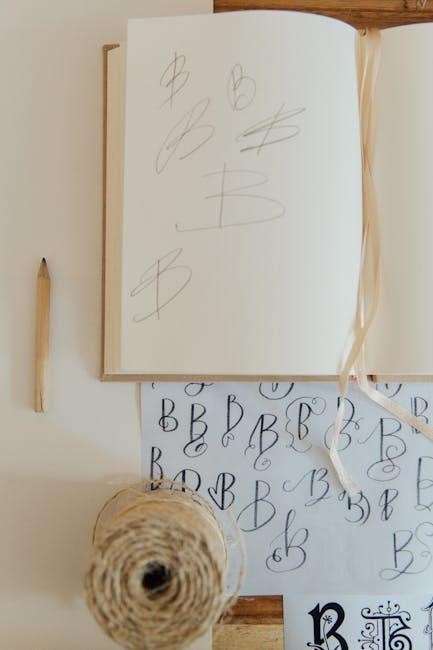Overview of 3rd Grade Writing Development
Third graders typically develop their writing skills by composing multi-paragraph texts, using descriptive language, and organizing thoughts logically. At this stage, students begin to write narratives, informative essays, and creative stories with more complexity. Worksheets and prompts play a crucial role in guiding them to structure sentences, use proper grammar, and express ideas clearly. Activities like “Draw and Write” encourage creativity, while story starters help build confidence; Free printable resources, such as PDF worksheets, provide teachers with tools to support individual learning styles. These materials are designed to align with curriculum goals, ensuring students progress in writing proficiency while fostering a love for creative expression and clear communication.
Importance of Writing Worksheets for Young Learners
Writing worksheets are essential for young learners as they provide structured practice, helping students build confidence and improve writing skills. These resources offer guided exercises tailored to developmental needs, ensuring a strong foundation in grammar, composition, and creativity. Worksheets like “Draw and Write” activities engage students visually, making learning interactive and enjoyable. Free printable PDFs, such as those designed for 3rd graders, allow teachers to offer diverse prompts that cater to individual interests and learning styles. By using these tools, students develop the ability to express ideas clearly and creatively, while teachers can track progress and provide constructive feedback, fostering a lifelong love for writing and self-expression.

Types of Writing Prompts for 3rd Graders
Third graders benefit from diverse writing prompts, including narrative, informative, descriptive, and creative exercises. These prompts are tailored to their developmental stage and include engaging activities like “Draw and Write” to inspire creativity and storytelling skills, ensuring age-appropriate challenges and fun learning experiences.
Narrative Writing Prompts
Narrative writing prompts for 3rd graders focus on storytelling, encouraging students to express personal experiences or imagined events. Worksheets often include creative scenarios, such as “A Stormy Day Adventure” or “If I Could Time Travel,” guiding students to develop characters, settings, and plotlines. These prompts help improve sequencing skills and descriptive language, making stories more engaging. Visual aids like story starters or “Draw and Write” activities further inspire creativity, allowing students to visualize their narratives before writing. Seasonal themes, like holiday experiences, also make these prompts relatable and fun, helping young writers build confidence in their storytelling abilities while adhering to curriculum goals.
Informative Writing Prompts
Informative writing prompts for 3rd graders are designed to help students explain topics clearly and concisely. Worksheets often include prompts like “What Do You Know About Butterflies?” or “How to Plant a Garden,” encouraging students to research and organize information. These exercises teach children to structure their writing logically, using introductions, supporting details, and conclusions. Visual aids, such as diagrams or charts, are often included to aid understanding and engagement. Informative prompts align with curriculum goals, reinforcing knowledge of science, history, or literature while developing writing skills. They also cultivate critical thinking as students gather and present facts on topics like animals, seasons, or community helpers.
Descriptive Writing Prompts
Descriptive writing prompts encourage 3rd graders to use vivid details to describe people, places, objects, or experiences. Worksheets often include scenarios like “Describe a Stormy Day” or “What Your Favorite Season Looks Like.” These prompts help students practice using sensory language to paint mental pictures. For example, prompts might ask students to describe attributes of a specific location, such as “What Houston Looks Like During a Holiday.” Visual aids, like pictures or diagrams, are often included to inspire creativity and guide young writers. Descriptive prompts also help students develop their vocabulary and ability to organize thoughts cohesively, making their writing more engaging and detailed. This skill is foundational for all forms of writing, fostering clear and imaginative expression.
Creative writing prompts inspire 3rd graders to think imaginatively and express unique ideas. Worksheets often feature fun scenarios like “If You Could Have Any Superpower” or “Imagine a World Without Gravity.” These prompts allow students to explore fantasy and adventure themes, fostering innovation in their writing. For instance, prompts might ask students to invent a new species or describe a magical kingdom. Activities like “Draw and Write” or “Finish the Story” also blend creativity with structure, helping students develop their narrative skills. By encouraging imaginative thinking, these prompts make writing enjoyable and help students build confidence in their ability to craft original stories and ideas. This approach ensures that learning is both engaging and effective, nurturing a lifelong love for creative expression. Worksheets enhance writing skills, foster creativity, and provide structured learning, helping 3rd graders develop confidence and clarity in their writing through guided and engaging activities. Using 3rd-grade writing prompts worksheets PDF helps students refine their writing abilities through consistent practice. These resources focus on grammar, spelling, and sentence structure, enabling learners to express ideas clearly. By completing exercises like descriptive writing and story starters, children improve their paragraph composition and narrative skills. The structured format of worksheets guides students in organizing thoughts logically, enhancing their ability to convey messages effectively. Regular use of these tools builds confidence and fluency, laying a strong foundation for advanced writing tasks. Additionally, the variety of prompts encourages students to explore different writing styles, fostering versatility and creativity in their work. This targeted practice helps students progress steadily, mastering essential writing skills at their own pace. Third-grade writing prompts worksheets PDF are designed to spark imagination and creativity in young writers. By presenting engaging scenarios and open-ended questions, these resources encourage students to think outside the box and explore unique ideas. For example, prompts like “If you could create a new holiday” or “Describe a magical world” inspire inventive thinking. The variety of topics, from seasonal themes to fantasy adventures, allows learners to express their individual perspectives. Visual aids and creative writing exercises further stimulate imaginative writing, helping students develop a personal voice. These tools not only build writing skills but also foster a love for creative expression, empowering students to craft original and compelling stories. Regular practice with such prompts enhances their ability to generate innovative ideas and articulate them effectively. Third-grade writing prompts worksheets PDF provide a clear framework for structured learning, helping students organize their thoughts and approach writing systematically. These resources often include step-by-step instructions and guided exercises, making it easier for young learners to grasp writing concepts. For instance, worksheets may ask students to start with a topic sentence, add supporting details, and conclude with a summary. This structured approach ensures students understand the writing process and can apply it to various prompts. The use of visual aids and sequential tasks further supports their ability to follow directions and complete assignments confidently. By breaking down writing into manageable parts, these worksheets help students build a strong foundation for future academic success. Regular practice with structured worksheets enhances their ability to write coherently and effectively. Selecting the right prompts involves aligning them with curriculum goals, matching student interests, and ensuring age-appropriateness to foster engagement and skill development effectively. Aligning writing prompts with curriculum goals ensures relevance and coherence in learning. Worksheets for 3rd graders should focus on skills like paragraph structure, descriptive writing, and narrative techniques, as outlined in educational standards. By selecting prompts that match what students are learning in class, teachers can reinforce key concepts and help students apply their knowledge effectively. For instance, if a lesson covers opinion writing, prompts like “Why is your favorite season the best?” can guide students to practice expressing their views. This strategic alignment not only enhances academic skills but also makes learning more purposeful and engaging for young writers. Matching student interests with writing prompts is crucial for engagement. Worksheets tailored to topics like animals, fantasy, or seasonal themes spark curiosity and motivation in 3rd graders. For example, prompts about favorite holidays or imaginary adventures resonate with children’s natural interests. By connecting writing activities to what students enjoy, educators foster a love for writing and encourage creative expression. This approach also helps students feel more confident and invested in their work, as they explore topics they find exciting or relatable. Incorporating fun and relevant themes ensures that learning is both enjoyable and meaningful, making the writing process a positive experience for young learners. Ensuring age-appropriateness in 3rd grade writing prompts worksheets is essential for effective learning. Worksheets should align with the developmental stage of 8-9 year olds, offering topics that are both challenging and achievable. Prompts should avoid overly complex vocabulary or concepts, ensuring students can grasp and respond to them confidently. Additionally, themes should be relevant to their everyday experiences or interests, such as pets, school events, or imaginative scenarios. Age-appropriate writing activities help students feel comfortable expressing themselves, fostering creativity and skill development. By tailoring content to their maturity level, educators provide a foundation for growth while keeping young learners engaged and motivated in their writing journey. Popular themes include seasonal and holiday topics, animal and nature adventures, and fantasy stories, engaging young writers and inspiring creativity through relatable and imaginative subjects. Seasonal and holiday themes are popular in 3rd-grade writing prompts, making learning engaging and fun. worksheets often feature Christmas, Halloween, or Valentine’s Day topics, encouraging students to write about traditions, experiences, or imaginary scenarios. these themes align with curriculum goals, sparking creativity and relatability. for example, christmas-themed prompts might ask students to describe their favorite holiday memory or imagine a day as santa. such activities not only foster descriptive writing skills but also allow students to express personal connections to celebrations. incorporating seasonal elements into writing worksheets makes learning enjoyable and relevant, helping young writers develop their skills in a playful and meaningful way. these prompts are designed to inspire creativity while keeping students motivated and excited about writing. Animal and nature topics are engaging themes for 3rd-grade writing prompts, inspiring creativity and curiosity. worksheets often feature prompts like describing a favorite animal, imagining a day in the forest, or writing about a fictional pet. these topics encourage students to explore their observations and imaginations, fostering descriptive and narrative writing skills. prompts like “What would you do if you could talk to animals?” or “Describe a magical garden” spark creativity while aligning with learning goals. such exercises help students develop vocabulary and express their thoughts about the natural world. by connecting writing to relatable and interesting subjects, these prompts make learning enjoyable and effective, while also nurturing a deeper appreciation for nature and its wonders. Fantasy and adventure stories are captivating themes for 3rd-grade writing prompts, inspiring imaginative and creative expression. Worksheets often include prompts like “Imagine you discovered a magical kingdom” or “Write about a brave adventurer’s journey.” These ideas encourage students to explore fantastical worlds, invent characters, and craft exciting plots. Such exercises help develop narrative skills and spark creativity, allowing young writers to express their unique ideas. By engaging with these themes, students learn to structure stories, use descriptive language, and convey emotions effectively. Fantasy and adventure topics make writing enjoyable and motivating, fostering a love for storytelling while enhancing overall writing abilities. These prompts are ideal for nurturing creativity and confidence in young learners. Effective worksheets for 3rd-grade writing prompts should prioritize clarity, simplicity, and visual aids. Incorporate guided instructions to help students stay focused and understand expectations clearly. Clarity and simplicity are essential when designing 3rd-grade writing prompts worksheets. Use clear, concise language in instructions and prompts to ensure students understand expectations. Avoid overly complex vocabulary or ambiguous questions that might confuse young learners. Simple layouts with ample white space reduce visual clutter, making the worksheet less intimidating. Large, readable fonts and straightforward formatting help students focus on the task without distractions. Clear examples or visual cues can guide students, especially for those needing additional support. Simplifying the design ensures that the focus remains on writing skills, making the learning process more effective and enjoyable for 3rd graders. Incorporating visual aids into 3rd-grade writing prompts worksheets enhances engagement and understanding. Images, charts, and diagrams can spark creativity and provide context for writing topics. For example, a picture of a seasonal scene can inspire descriptive writing, while a simple flowchart might guide students through the writing process. Visual elements like word banks or sentence starters can also support learners who need additional help. Additionally, illustrated prompts, such as “Draw and Write” activities, allow students to express their ideas visually before transitioning to written form. This multi-sensory approach makes learning interactive and accessible, catering to different learning styles and fostering a more dynamic writing experience for young students. Providing guided instructions in 3rd-grade writing prompts worksheets ensures students understand expectations and feel confident in their writing abilities. Clear directions, such as step-by-step prompts or example sentences, help learners grasp the task. Worksheets often include sentence starters or word banks to guide young writers, making the process less daunting. For instance, a prompt might ask students to describe a favorite animal, with visual cues like “Name the animal: ______” or “What does it look like? ______.” These structured guides not only foster independence but also encourage creativity while keeping students on track. Additionally, visual step-by-step instructions, such as “Draw a picture first, then write a sentence about it,” help students organize their thoughts and produce coherent writing. Interactive and fun approaches make writing enjoyable for 3rd graders. Activities like draw-and-write, story starters, and group exercises keep students excited and engaged in learning. Draw and write activities are an engaging way to encourage young writers to express their creativity. These exercises typically involve drawing a picture first, followed by writing a short sentence or paragraph to describe it. For example, students might draw a scene depicting a storm or a specific location like Houston, then write about what happened there. These activities are particularly effective for reluctant writers, as the visual element provides a foundation for their writing. The process helps students connect their ideas visually before translating them into words, fostering both creativity and composition skills. Older students can expand their writing by crafting full paragraphs based on their drawings, making this approach versatile and developmental for various skill levels. This method is also ideal for incorporating seasonal or thematic elements, keeping students motivated and excited about writing. By combining art and writing, draw-and-write activities create a fun and interactive learning experience that caters to different learning styles and abilities. They are especially popular in elementary grades, where they help build confidence and foundational writing skills in a playful and accessible way. Story starters and “Finish the Story” activities are excellent tools for sparking creativity in young writers. These prompts provide a beginning scenario, such as “What happened during a storm?” or “If you could bring back an extinct species, what would it be?” Students are then encouraged to complete the story using their imagination. This approach helps build narrative skills and encourages students to think critically about plot development and character creation. Worksheets often include visual aids or guiding questions to support students as they write. For example, a prompt might ask students to describe a fantasy world or imagine life in a different time period. These activities are designed to be fun and engaging, making the writing process feel like an adventure rather than a chore. By providing a starting point, story starters help students overcome writer’s block and confidently express their ideas. This method is particularly effective for 3rd graders, as it allows them to explore their creativity while practicing essential writing skills. Additionally, teachers can use these prompts to assess students’ understanding of storytelling elements and their ability to structure a coherent narrative. With story starters, the possibilities are endless, and students can let their imaginations shine. Many free printable worksheets and PDF guides are available online, offering a wide range of themes and topics to suit different interests and learning styles. These resources are especially helpful for educators seeking to create engaging and interactive lessons. By incorporating story starters into the classroom, teachers can foster a love for writing and help students develop into confident storytellers. Group writing exercises are a dynamic way to engage 3rd graders in collaborative storytelling and problem-solving. These activities encourage teamwork, creativity, and communication. Students work together to create a shared story or solve a writing challenge, fostering a sense of camaraderie and shared ownership. Teachers can provide prompts like “Create a class story together” or “Write a group poem about a seasonal theme.” Visual aids and guided instructions help students stay focused and contribute effectively. Group writing also allows students to learn from one another, building confidence and fostering a supportive learning environment. This approach not only enhances writing skills but also promotes critical thinking and collaboration. Many free printable worksheets and PDF guides offer group exercises tailored for young learners, making it easy for educators to implement these activities in the classroom. By working together, students develop essential life skills while enjoying the process of creating something meaningful as a team. Assessment and feedback are crucial for tracking student progress in writing. Evaluating work helps identify strengths and areas for improvement, while constructive feedback guides young writers to refine their skills and develop a love for writing. Evaluating student work in 3rd grade writing involves assessing creativity, coherence, and adherence to prompts. Teachers use rubrics to score writing based on grammar, vocabulary, and structure. Peer reviews encourage constructive feedback, fostering a supportive environment. Regular checks on progress help identify areas needing improvement. Timing and consistency ensure fair evaluation, while digital tools offer innovative ways to track growth. This comprehensive approach ensures students receive clear guidance, empowering them to enhance their writing skills effectively; Constructive feedback is essential for helping 3rd graders improve their writing. Teachers should focus on specific strengths and areas for growth, using positive language to encourage confidence. For example, highlighting a well-crafted sentence while suggesting improvements in clarity or grammar. Providing actionable steps, such as rewriting a paragraph or adding details, helps students understand how to enhance their work. Feedback should also guide students to reflect on their own writing, fostering self-assessment skills. By balancing praise with targeted suggestions, educators create a supportive environment where students feel motivated to refine their writing abilities and take pride in their progress. Tracking progress over time is crucial for monitoring improvements in 3rd graders’ writing skills. Using worksheets and prompts regularly allows educators to observe development in clarity, grammar, and creativity. By reviewing completed worksheets, teachers can identify consistent strengths and areas needing attention. Students also benefit from seeing their own growth, which boosts confidence and motivation. Over time, the structured activities help learners refine their writing abilities, transitioning from simple sentences to more complex compositions. This longitudinal approach ensures that writing skills are consistently nurtured, providing a clear path for continued improvement and a strong foundation for future academic success. Explore free printable worksheets, PDF guides, and recommended websites offering a variety of 3rd grade writing prompts to enhance learning and engagement for young writers. Free printable worksheets for 3rd grade writing prompts are widely available online, offering diverse topics like narrative, informative, and creative writing. These resources are designed to be fun and educational, helping students develop their writing skills through engaging activities. Many websites provide seasonal and themed sheets, such as holiday prompts or animal-related topics, to keep learning exciting. Teachers and parents can easily download these PDFs, which often include guided instructions and visual aids to support young writers. With just a click, these worksheets can be printed and used in classrooms or at home, making them a convenient tool for fostering a love for writing in children. Several websites offer excellent resources for 3rd grade writing prompts worksheets in PDF format. Education.com and Teachers Pay Teachers are popular platforms, providing a wide range of free and paid printable materials. These sites cater to various writing styles, including narrative, informative, and creative prompts. They also offer seasonal and themed worksheets, making learning engaging for students. Additionally, ReadWriteThink.org is another reliable source, offering interactive tools and guides to support writing instruction. These websites are designed to save teachers time while ensuring high-quality educational content. Many also provide customizable options, allowing educators to tailor resources to their classroom needs, making them invaluable for teaching writing effectively. PDF guides and workbooks are invaluable resources for teaching 3rd grade writing prompts. These downloadable materials offer structured lessons, creative exercises, and printable worksheets tailored to young learners. Many PDF guides focus on specific writing skills, such as narrative, informative, and descriptive writing, while others provide comprehensive workbooks that cover multiple styles. They often include activities like “Draw and Write” and seasonal themes to engage students. Teachers can easily print these resources for classroom use, ensuring consistency and accessibility. Additionally, some PDF workbooks include answer keys and teaching tips, making them a convenient tool for educators. These guides are designed to foster creativity, improve writing skills, and cater to diverse learning needs, making them an essential part of any 3rd grade writing curriculum. 3rd grade writing prompts worksheets PDF empower young writers, fostering creativity and essential writing skills through engaging activities, making learning fun and effective for students and educators alike. Effective writing instruction for 3rd graders involves using engaging tools like worksheets and prompts to foster creativity and skill development. These resources provide structured yet fun learning experiences, helping students build confidence in expressing their ideas. By incorporating seasonal themes, animal topics, and imaginative scenarios, worksheets cater to diverse interests and learning styles. Teachers can align these materials with curriculum goals to ensure comprehensive skill development. Regular practice with prompts enhances writing abilities, encouraging students to think critically and creatively. Over time, these activities not only improve writing skills but also nurture a lifelong love for writing in young learners, making them more articulate and expressive individuals. Encouraging a love for writing in 3rd graders is essential for their academic and personal growth. Using engaging worksheets and prompts, teachers can make writing fun and meaningful. Seasonal themes, animal stories, and imaginative scenarios spark curiosity and creativity, helping students enjoy the writing process. Providing positive feedback and celebrating progress builds confidence and motivation. Incorporating activities like “Draw and Write” or “Finish the Story” makes writing feel less like a chore and more like an adventure. By fostering a positive relationship with writing, educators help students develop a lifelong appreciation for self-expression and communication, turning them into confident and creative writers.Creative Writing Prompts

Benefits of Using Worksheets

Improved Writing Skills
Enhanced Creativity
Structured Learning

How to Choose the Right Writing Prompts
Aligning with Curriculum Goals
Matching Student Interests
Ensuring Age-Appropriateness

Popular Themes for 3rd Grade Writing
Seasonal and Holiday Themes
Animal and Nature Topics
Fantasy and Adventure Stories

Designing Effective Worksheets
Clarity and Simplicity
Incorporating Visual Aids
Providing Guided Instructions

Interactive and Fun Approaches
Draw and Write Activities
Story Starters and Finish the Story
Group Writing Exercises

Assessment and Feedback
Methods for Evaluating Student Work
Providing Constructive Feedback
Tracking Progress Over Time

Additional Resources
Free Printable Worksheets Online
Recommended Websites for Teachers
PDF Guides and Workbooks
Final Thoughts on Effective Writing Instruction
Encouraging a Love for Writing

